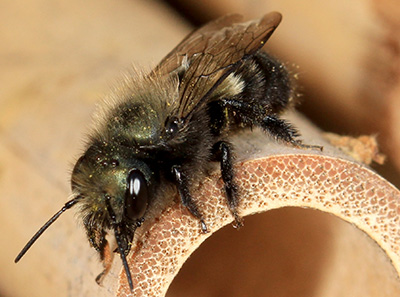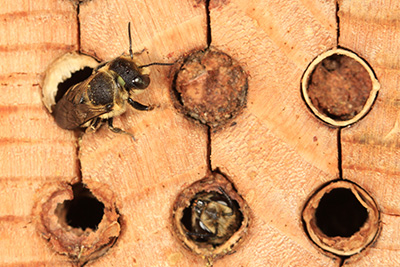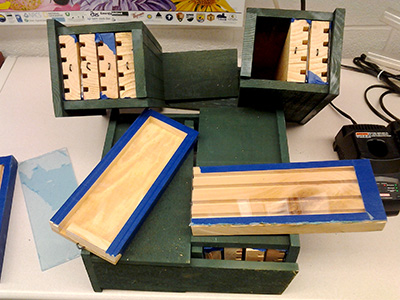Mason and leafcutter beekeeping
Like the idea of keeping bees, but not the idea of stings, swarms or lifting heavy boxes of sticky honey? Keeping other native pollinators might be for you.

Honey bees get their name from their high-energy food source. They remain active as an entire colony throughout winter by collecting nectar in summer just as fast as plants produce, which they convert into honey. Open up a honey bee hive in January and you will see a cluster of living bees that maintain a core temperature of over 90 degrees Fahrenheit. Pollen is collected in the warm months specifically to feed baby bees. It is collected most heavily in the spring, and in consistently lowering levels until the last brood is capped in October.
In contrast, most native bees live solitary lives. They are active as adults for a relatively short period of time – three to four weeks, depending on the species – and are dormant through winter. As such, they collect nectar mainly to fuel their flight to find and prepare nesting sites and to find and collect pollen to feed their larvae. Some people call them pollen bees because they do not make honey. Since solitary bees don’t have rich stores of honey, they do not defend their nests from large mammals, like ourselves.
Most native bees nest in underground burrows, but others occupy pre-existing cavities in fallen trees, stumps, old stems or manmade materials. Mason bees are early foraging cavity-nesters that live their adult lives almost entirely in spring. Their close relatives, the leafcutters, emerge later and can be found all summer long. The same sorts of nesting concepts apply to both, and to attract and build up their numbers in an area can be a low investment and satisfying enterprise.
Drilling 6 inches deep into dead tree stumps with a 1/8- to 3/8-inch bit will attract mason and leafcutting bees looking for nesting sites, but these will be difficult to manage and inspect for diseases or parasites. Michigan State University Extension recommends using a better method of using materials that either open for inspection and cleaning, such as boards that have grooves routed into them and are clamped together to create the effect of holes in a block of wood, or by using loose materials that can be periodically replaced.
To keep parasitoid wasps and flies that target aggregations of mason and leafcutter bee cells from becoming a perennial pest of unmanaged drilled-hole nests, it is important to protect the nests after they have finished being active for the season. The simplest protection measure is to secure a swath of bridal tulle, cheesecloth or a paint strainer bag over the capped nesting holes to exclude parasitoid wasps and flies. If you have a healthy woodpecker population, you might consider mounting some 0.5-inch wire screen about 1 inch away from the entrances as well.
Instead of wood, cardboard straws, which can be purchased through a variety of suppliers, or cut pieces of reed grasses or bamboo with one end capped with a natural node allows them to be removed from the nesting area for protected storage. It also makes it easy to add additional nesting materials the following year, replacing old nesting material on a three-year cycle to keep disease and parasite populations from building up in the nesting area.

Blue orchard mason bee using a bamboo nesting tube. Photo credit: Jason Gibbs, MSU
For managing these bees on a larger scale, like for fruit or vegetable pollination, the next step is to line potential nesting holes with paper tube that can be slipped out. This is so that they can be split open to remove cocoons and clean them of mites, and dispose cocoons that have been parasitized by wasps and flies to prevent a future infestation. Or, use a nesting block design that features a series of stacked wood trays about 1 inch thick, with 1/8- to 3/8-inch channels routered or sawn into them, spaced about 0.5- 1 inch apart. These can be placed into a tight-fitting enclosure to restrict parasitoid wasp movement between trays, or they can be held together by a ratchet strap or threaded rods and nuts. Most manufactured tray-style nesting blocks are about 6 inches deep, but trays up to 11 inches deep are also used with success.

Alfalfa leafcutter bees using a splitting wood nesting block with paper liners. Photo credit: Jason Gibbs, MSU
If you choose to remove mason bee or leafcutter tubes or cocoons for protection, inspection or cleaning, place them in a ventilated and insulated container at ambient environmental temperature. A vented cooler placed in a garage or poll barn is a great place. You can sanitize trays and holes with bleach, and scrape them clean with a soft wire brush.
These management techniques have been honed by the pollination service industry for increasing efficiency and profitability in tree fruit and alfalfa seed production, and from the research and education sector for observing their nesting habits. In any case, some protection from direct rain is helpful.
A demonstration of all of these techniques and more will occur at the fourth annual MSU Bee Palooza, Sunday, June 7, 2015, from 1-4 p.m. at the MSU Horticultural Gardens, 1066 Bogue Rd, East Lansing, MI 48529. For more information, visit the MSU Bee Palooza Facebook page.

A set of easy to inspect tray-style nesting boxes designed by Gord Hutchings of Hutchings Bee Services and built by Dan Keane from the Saginaw Conservation District. They are installed at MSU’s Horticultural Gardens and can be seen at the fourth annual MSU Bee Palooza. Photo credit: Ben Phillips, MSU Extension



 Print
Print Email
Email

